Where is God? (A History of God)
The Hebrew Biblical View
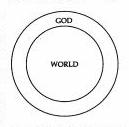 |
| The Hebrew Biblical View |
In the biblical time of the Old Testament the Hebrew God and the world were not
antithetical, nor were they identical. God was the creator; the world was the creature.
God was bigger than the creation, but the creation revealed the creator’s glory. The
Hebrew creation story affirmed the goodness of life. God made it all, and when it was
complete God surveyed it and pronounced it good indeed. The physical world was the object
of God’s love. It was showered with God’s blessings: sunshine and rainfall. For human
life a garden was built called Eden. God walked in the garden “in the cool of the
evening”
(Gen 3:8).
Material things were good; they were meant to be used. Physical
things were good; they were meant to be appreciated. Life was good; it was meant to be
lived. The world was good; it was the object of the divine love and was therefore meant
to be engaged. With great joy the Hebrews could sing of God’s world and God’s creation.
To be spiritual for the Hebrews meant to be alive to God and alive to the world. It did
not mean to be pious or otherworldly. To have faith, for the Hebrew, was to have the
courage to enter life, for that is where God is to be found.
The Early Christian Dualistic View
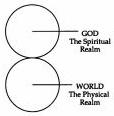 |
| The Early Christian Dualistic View |
Christians took on a dualistic view, which was adapted from the Greeks. There is a
separation between the spiritual and the physical, between God and the world.
Christianity and the church were identified with the realm of the spirit, and all worldly
pursuits and physical concerns were identified with the realm of the physical. The world
became a place to be escaped, not to be engaged. Christians who followed the “higher
calling” turned their backs on life and gave themselves to the “spiritual” pursuits of
prayer, meditation, contemplation. The goal of the Christian life was now not the
transformation of the world but the beatific vision. Otherworldly concerns became
dominant. The meaning of life was not found in life but beyond it. The goal of life was
heaven, not earthly fulfillment. As the church grew in dominance the realm of the spirit
with which the church had made its special identification grew in importance, while the
realm of the physical began to shrink as an object of concern. This attitude reached its
culmination, its highwater mark, in the thirteenth century.
The Thirteenth Century
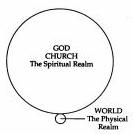 |
| Thirteenth Century |
By the thirteenth century life on earth was considered only temporary and therefore just
something to be endured. In such a world no passion for life was exhibited, no war
against injustice was fought, no reform movements were initiated. This world was
considered too unimportant to be worthy of serious efforts at change. There was a
sanctified mood of resignation, of acceptance of one’s status or circumstances, because
life here did not really matter that much.
This fact has had its ramifications in our later history. Because efforts to reform life
in this world, to increase justice among men and women, to throw off the shackles of
human bondage were not the concern of Christians, they inevitably had to become the
concern of non-Christians. This spiritualized, benign neglect by the church of the
festering sores of injustice guaranteed that reform movements in Western civilization
would be violently anti-Christian movements. One has only to look at the French
Revolution, the Russian Revolution, the Spanish Revolution to see on which side the
institutional church took its stand. It was the pious, otherworldly attitude in the face
of overt oppression and injustice that caused Karl Marx to write his famous words,
“Religion...is the opium of the people.”
Given the anti-world, anti-physical reality stance of thirteenth-century Christianity,
the science-versus-religion battle was unavoidable. When scientific pursuits emerged in
Western civilization, they were inevitably anti-Christian and antireligious.
The Church vs. Science
By the sixteenth century scientific facts begin to confront Christian theological dogma.
God is no longer required to explain what science can explain without God. God becomes a
gap-filler God. Wherever gaps in human knowledge or experience exist God is cited to
explain it. As science expands the role of God diminishes.
Step by step, from contest to ultimate conquest, in every single conflict of Fact with Faith,
the Church has been defeated and has retreated -- put to shaming rout. It has been a slow
and tortuous progress,--
"For faith, fanatic faith, once wedded fast
To some dear falsehood, hugs it to the last"!
The process of adjustment for the Church has throughout a thousand instances been the
same: Faith is confronted with a discrediting Fact; it curses it and denies it. It
viciously persecutes anyone who sides with science rather than with the Church because
the Church desperately wants to retain its power. Any scientific knowledge which
diminishes the role of God also diminishes the power of the Church.
When a scientific fact is finally crammed down the Church's throat and they are forced to
change their dogma they then claim the Bible supported the scientific view all along and
they just made a "mistake" in interpreting scripture, oh and sorry for all those people
they burned at the stake.
But the self-inflicted damage the Church does to itself takes its toll. Their ultimate
infallible authority is brought into question and the Church is irreversibly humiliated.
People loose respect for the Church. People gain respect for science.
The Post-Copernicus World
 |
| The Post-Copernicus World |
Astronomy brought the first heavy blow to Christian dogma as it became increasingly
evident that the earth was round and that the sun, not the earth, was the center of our
solar system. God was no longer "up there," above the sky, and God was no longer needed
to explain the motion of the planets. The realm of the spirit world shrank, the realm of
the physical world expanded.
The Post-Darwin World
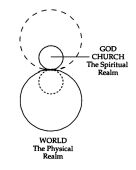 |
| The Post-Darwin World |
Biology brought the next heavy blow to Christian dogma. The scientific theory of
evolution again challenged the authority of scripture as God was no longer required to
explain where all living things came from.
The science vs. religion battle was again engaged. Its echoes are still being heard
today. The Scopes trial in Tennessee was a twentieth-century phenomenon, commanding
front-page news in every paper in America. With the administration of Orval Faubus in
Arkansas (1955-1967), the teaching of evolution was prohibited in the public schools of
that state in the name of defending religious truth.
With the revival of fundamentalism in the 1980s and 1990s the new code word for this
antiquated point of view was "creation science." Even today Christian radio stations
broadcast shows which try to ridicule the theory of evolution. They even try to use
science to refute science. See
Cosmology and The 2nd Law of Thermodynamics.
As was the case with the theory of a heliocentric universe, however, the theory of
evolution has become accepted, and the theory now undergirds every biology textbook in
this land. Once again the realm of the spirit world shrank and the realm of the physical
continued to expand. An external deity was no longer required to explain the existence
of life itself.
The Death of God
 |
| The Death of God |
Twentieth-century life is totally centered in the physical realm. Ours is a
materialistic, scientific age. The realm in which we have located God has been diminished
to the point of nonexistence. Many are the voices that want us to resurrect the spiritual
realm by artificial respiration. “Back to the Bible!” they plead; “back to the old-time
religion.” But that would be like doing plastic surgery on a corpse. God is dead.
The New Search For Meaning
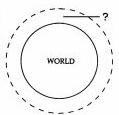 |
A Nonreligious World
and the
Search For Meaning |
Today we yearn for a religion that is life-centered, not life-denying. Our passion is for life.
Our call is into life. We seek to be alive to this world. We seek a spiritual reality
that permeates this here-and-now world. We seek a faith that will give us the courage to
enter into life, to live life, to experience life. A good person is a whole person, a
free person, the realized person.
We have come full circle. We have returned to our ancient Hebrew roots.
Today we do not call what we seek "God," because we still associated "God" with that
other worldly spiritual realm that is dead. Instead we have no name for what we seek. It
is greater than anything that can be named. No name can confine this concept.
Perhaps rather than calling what we seek "God," we should just call it "?" That is, we
seek what can not be named. It is what it is.
God, in all actuality, has no name.
When Moses asked for God's name God responded with a very enigmatic Hebrew phrase that
was and is difficult to translate. The suggested translations are: "I am who I am" or
"I will be what I will be" or "I am the one who causes everything that is to be."
(Exodus 3:14).
The name of God was in some way related to the verb "to be." God was being, being itself.
God is. Of this God it could be said that "the eternal and complete 'I' shares, undergirds,
and affirms the eternal and complete world that is." "I Am" was their way of saying this,
of describing the indescribable.1
The God of our ancient Hebrew roots permeated our universe. We pushed God outside our
universe, and God died there. We can not seek the God that exists within our universe
until we let go of the God that existed outside our universe. Today we seek the God that
is here, the God that is with us, within us, and without us.
The Hebrew Jesus of Nazareth is the one who was recorded as having said: "I have come that
you might have life and have it abundantly"
(John 10:10).
He is also the one who is portrayed as charging his disciples to go into all the world
to reveal discipleship through love. The Christian story, when viewed in the context of
its ancient Hebrew roots, asserts that if one wants to look for God, one must look at
life, at history, and at the world. That is the specific message of the gospel account,
a gospel born in a Hebrew world.
[1] The Hebrew word 'yeh-ho-vaw', translated 'Lord', has as its
root the word 'hayah' meaning "I Am." In Hebrew Exodus 3:14 reads 'hayah hayah',
which is translated "I Am That I Am."
(See 'yeh-ho-vaw', Strong's Hebrew #03068
and its root word 'hayah', Strong's Hebrew #01961)
The above is condensed and paraphrased from chapter 3 of the book
This Hebrew Lord : A Bishop's Search for the Authentic Jesus
by Bishop John Shelby Spong.
Parts are also taken from the book
Rescuing the Bible from Fundamentalism : A Bishop Rethinks the Meaning of Scripture,
also by Bishop John Shelby Spong.
[View an excellent entertaining lecture by Bishop John Shelby Spong] [offsite]








